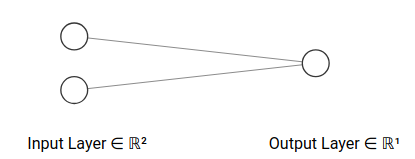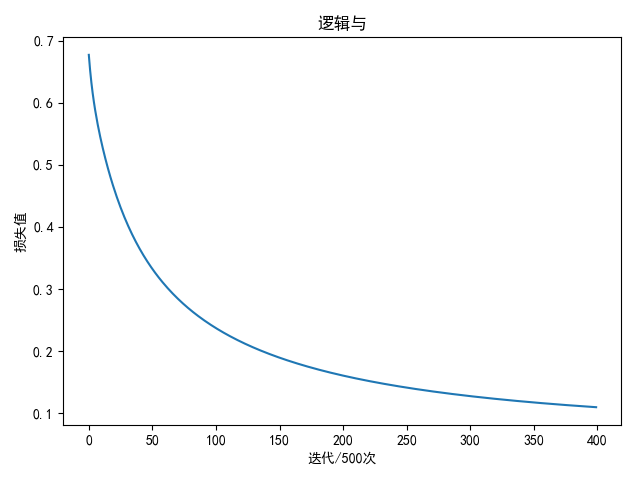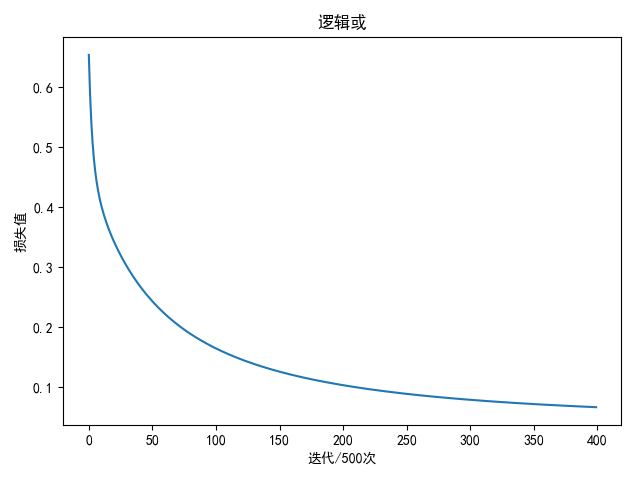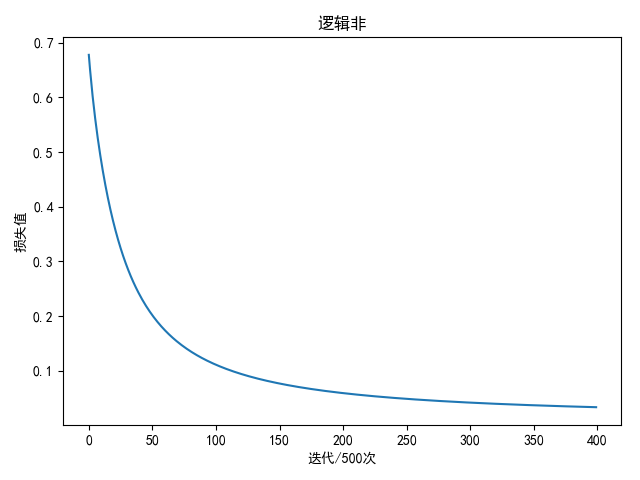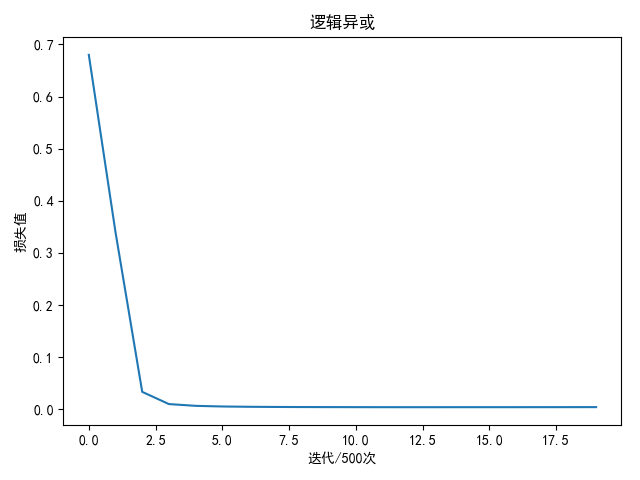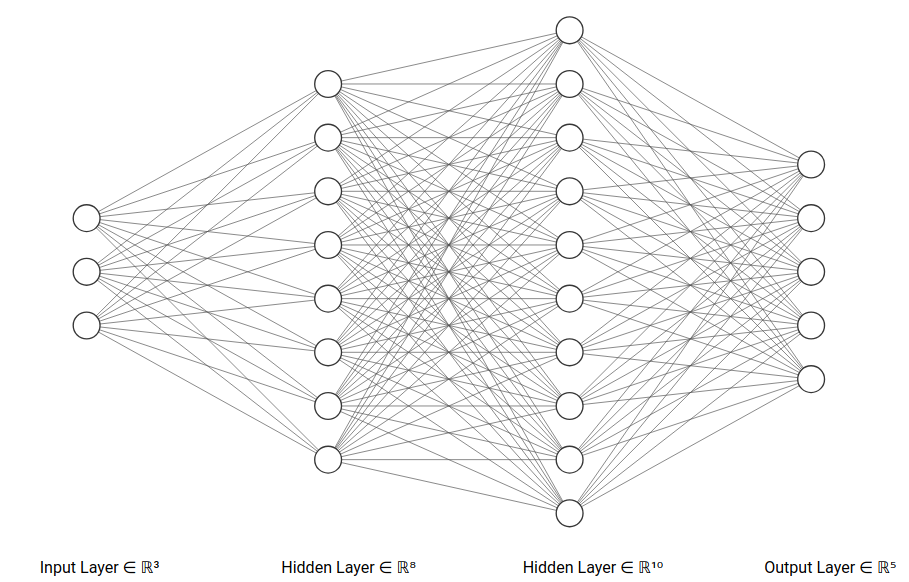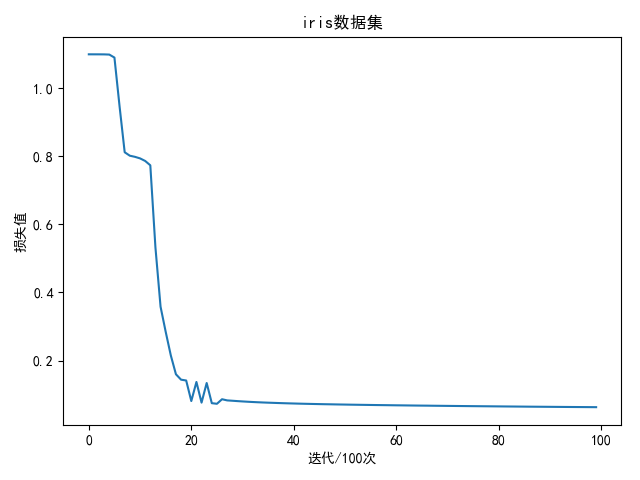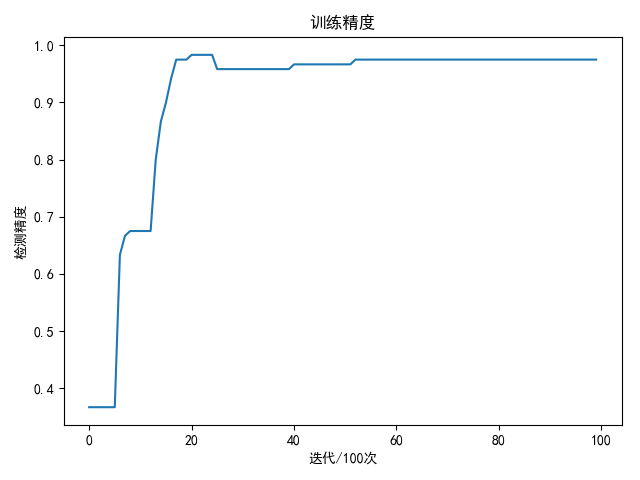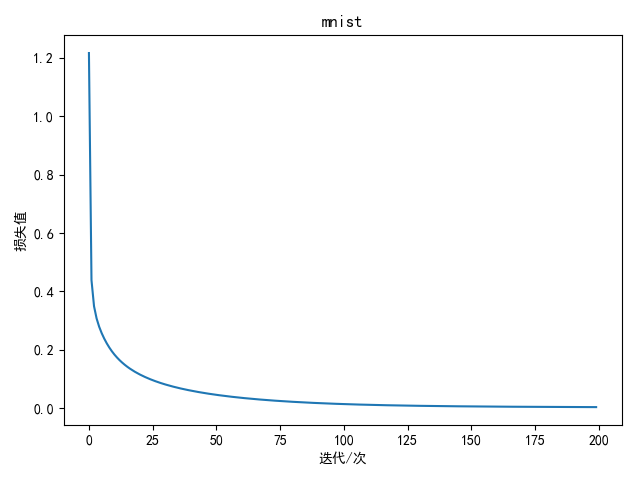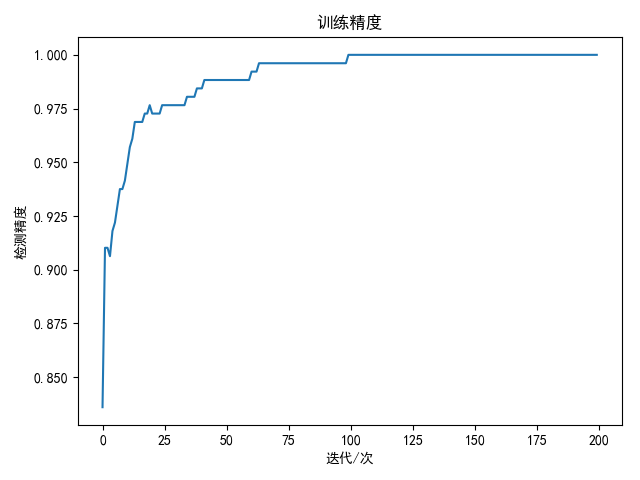使用numpy实现神经网络模型
使用单层神经网络OneNet实现逻辑或、逻辑与和逻辑非分类 使用2层神经网络TwoNet实现逻辑异或分类 使用3层神经网络ThreeNet实现iris数据集和mnist数据集分类 使用单层神经网络OneNet实现逻辑或、逻辑与和逻辑非分类 使用单层神经网络OneNet
输入层有2个神经元 输出层有1个神经元 评分函数是sigmoid 损失函数是交叉熵损失 OneNet就是逻辑回归模型
\(L=1\) \(a^{(0)}\in R^{m\times 2}\) \(W^{(1)}\in R^{2\times 1}\) \(b^{(1)}\in R^{1\times 2}\) \(y\in R^{m\times 1}\) ,每行数值表示正确类别(0或者1)前向传播过程
\[ z^{(1)}=a^{(0)}\cdot W^{(1)} +b^{(1)} \\ h(z^{(1)})=p(y=1)=sigmoid(z^{(1)})=\frac {1}{1+e^{-z^{(1)}}} \\ \]
所以分类概率是
\[ probs=[p(y=0), p(y=1)]=[1-h(z^{(1)}), h(z^{(1)})]\\ =[\frac {e^{-z^{(1)}}}{1+e^{-z^{(1)}}}, \frac {1}{1+e^{-z^{(1)}}}] \in R^{m\times 2} \]
损失值是
\[ J(z^{(1)})=-\frac {1}{m} 1^{T}\cdot (y* \ln h(z^{(1)})+(1-y)* \ln (1-h(z^{(1)}))) \]
因为OneNet很特殊(类别不是0就是1),所以损失值可以用下式计算
\[ J(z^{(1)})=-\frac {1}{m} (y\cdot \ln h(z^{(1)})+(1-y)\cdot \ln (1-h(z^{(1)}))) \]
反向传播过程
计算最终残差\(\delta^{(L)}\)
\[ dJ=d(-\frac {1}{m} 1^{T}\cdot (y* \ln h(z^{(1)})+(1-y)* \ln (1-h(z^{(1)}))))\\ =d(-\frac {1}{m} 1^{T}\cdot (y* \ln h(z^{(1)})))+d(-\frac {1}{m} 1^{T}\cdot (1-y)* \ln (1-h(z^{(1)}))) \]
因为
\[ d(-\frac {1}{m} 1^{T}\cdot (y* \ln h(z^{(1)})))= d(-\frac {1}{m} 1^{T}\cdot (y* (h(z^{(1)})^{-1}\cdot dh(z^{(1)})))\\ =d(-\frac {1}{m} 1^{T}\cdot (y* (h(z^{(1)})^{-1}\cdot h(z^{(1)})\cdot (1-h(z^{(1)})* dz^{(1)}))))\\ =d(-\frac {1}{m} 1^{T}\cdot (y* ((1-h(z^{(1)})* dz^{(1)}))))\\ =d(-\frac {1}{m} y^{T}\cdot ((1-h(z^{(1)})* dz^{(1)})))\\ =d(-\frac {1}{m} y^{T} * (1-h(z^{(1)})^{T}\cdot dz^{(1)})) \]
\[ d(-\frac {1}{m} 1^{T}\cdot (1-y)* \ln (1-h(z^{(1)})))=d(-\frac {1}{m} 1^{T}\cdot (1-y)* ((1-h(z^{(1)}))^{-1}\cdot d(1-h(z^{(1)}))))\\ =d(-\frac {1}{m} 1^{T}\cdot (1-y)* ((1-h(z^{(1)}))^{-1}\cdot (-1)\cdot (1-h(z^{(1)}))\cdot h(z^{(1)})* dz^{(1)}))\\ =d(-\frac {1}{m} 1^{T}\cdot (1-y)* ((-1)\cdot h(z^{(1)})* dz^{(1)}))\\ =d(\frac {1}{m} 1^{T}\cdot (1-y)* (h(z^{(1)})* dz^{(1)}))\\ =d(\frac {1}{m} (1-y)^{T}\cdot (h(z^{(1)})* dz^{(1)}))\\ =d(\frac {1}{m} (1-y)^{T}* h(z^{(1)})^{T}\cdot dz^{(1)}) \]
所以
\[ dJ=d(-\frac {1}{m} y^{T} * (1-h(z^{(1)})^{T}\cdot dz^{(1)}))+ d(\frac {1}{m} (1-y)^{T}* h(z^{(1)})^{T}\cdot dz^{(1)})\\ =d(\frac {1}{m} ((1-y)^{T}* h(z^{(1)})^{T} - y^{T} * (1-h(z^{(1)})^{T})\cdot dz^{(1)}))\\ =d(\frac {1}{m} (h(z^{(1)})^{T}-y^{T}* h(z^{(1)})^{T} - y^{T} + y^{T}* h(z^{(1)})^{T})\cdot dz^{(1)}))\\ =d(\frac {1}{m} (h(z^{(1)})^{T}- y^{T})\cdot dz^{(1)})) \]
\[ D_{z^{(1)}}f(z^{(1)})=\frac {1}{m}\cdot (h(z^{(1)})^{T}- y^{T})\\ \bigtriangledown_{z^{(1)}}f(z^{(1)})=\frac {1}{m}\cdot (h(z^{(1)})- y) \]
因为OneNet是单层神经网络,所以仅有一个权重矩阵和偏置值
\[ z^{(1)}=a^{(0)}\cdot W^{(1)} +b^{(1)}\\ dz^{(1)}=a^{(0)}\cdot dW^{(1)} + db^{(1)}\\ dJ=d(\frac {1}{m} (h(z^{(1)})^{T}- y^{T})\cdot dz^{(1)}))\\ =d(\frac {1}{m} (h(z^{(1)})^{T}- y^{T})\cdot (a^{(0)}\cdot dW^{(1)} + db^{(1)})))\\ =d(\frac {1}{m} (h(z^{(1)})^{T}- y^{T})\cdot a^{(0)}\cdot dW^{(1)})+d(\frac {1}{m} (h(z^{(1)})^{T}- y^{T})\cdot db^{(1)})\\ \]
\[ D_{W^{(1)}}f(W^{(1)})=\frac {1}{m}\cdot (h(z^{(1)})^{T}- y^{T})\cdot a^{(0)}\\ \bigtriangledown_{W^{(1)}}f(W^{(1)})=\frac {1}{m}\cdot (a^{(0)})^{T}\cdot (h(z^{(1)})- y) \]
\[ D_{b^{(1)}}f(b^{(1)})=\frac {1}{m}\cdot \sum_{i=1}^{m} (h(z_{i}^{(1)})^{T}- y^{T}_{i})\\ \bigtriangledown_{b^{(1)}}f(b^{(1)})=\frac {1}{m}\cdot \sum_{i=1}^{m} (h(z_{i}^{(1)})- y_{i}) \]
偏置向量需要考虑维数
进行权重更新时添加正则化项
\[ W^{(1)} = W^{(1)} - \alpha\cdot (\nabla_{W^{(1)}} J(W, b)+\lambda \sum W^{(1)}) \]
numpy实现 1 2 3 4 5 6 7 8 9 10 11 12 13 14 15 16 17 18 19 20 21 22 23 24 25 26 27 28 29 30 31 32 33 34 35 36 37 38 39 40 41 42 43 44 45 46 47 48 49 50 51 52 53 54 55 56 57 58 59 60 61 62 63 64 65 66 67 68 69 70 71 72 73 74 75 76 77 78 79 80 81 82 83 84 85 86 87 88 89 90 91 92 93 94 95 96 97 98 99 import matplotlib.pyplot as pltimport numpy as npN = 4 D = 2 K = 1 def init_weights (inputs, outputs ): return 0.01 * np.random.normal(loc=0.0 , scale=1.0 , size=(inputs, outputs)) class OneNet (object def __init__ (self, w, b ): self.w = w self.b = b def forward (self, inputs ): """ 前向计算,计算评分函数值 """ self.m = inputs.shape[0 ] self.a0 = inputs self.z1 = inputs.dot(self.w) + self.b self.h = self.sigmoid(self.z1) return self.h def backward (self, output ): """ 反向传播,计算梯度 """ delta = (self.h - output) / self.m self.dw = self.a0.T.dot(delta) self.db = np.sum (delta, axis=0 ) def update (self, alpha=1e-3 , la=1e-3 ): """ 更新梯度 """ self.w = self.w - alpha * (self.dw + la * np.sum (self.w)) self.b = self.b - alpha * self.db def sigmoid (self, inputs ): return 1.0 / (1 + np.exp(-1 * inputs)) def get_parameters (self ): return self.w, self.b def compute_loss (score, y, beta=0.0001 ): loss = -1.0 / score.shape[0 ] * (y.T.dot(np.log(score + beta)) + (1 - y).T.dot(np.log(1 - score + beta))) return loss[0 ][0 ] def draw (loss_list, title='损失图' ): plt.title(title) plt.ylabel('损失值' ) plt.xlabel('迭代/500次' ) plt.plot(loss_list) plt.show() if __name__ == '__main__' : w = init_weights(D, K) b = init_weights(K, D) net = OneNet(w, b) input_array = np.array([[0 , 0 ], [0 , 1 ], [1 , 0 ], [1 , 1 ]]) or_array = np.array([[0 , 0 , 0 , 1 ]]).T loss_list = [] total_loss = 0 for i in range (200000 ): score = net.forward(input_array) total_loss += compute_loss(score, or_array) net.backward(or_array) net.update() if (i % 500 ) == 499 : print('epoch: %d loss: %.4f' % (i + 1 , total_loss / 500 )) loss_list.append(total_loss / 500 ) total_loss = 0 w, b = net.get_parameters() print('weight: {}' .format (w)) print('bias: {}' .format (b)) print('输入 输出 预测成绩' ) score = net.forward(input_array) for item in zip (input_array, or_array, score): print(item[0 ], item[1 ][0 ], item[2 ][0 ]) draw(loss_list, '逻辑与' )
逻辑与 输入值与输出值
(0,0) - 0 (0,1) - 0 (1,0) - 0 (1,1) - 1 1 2 input_array = np.array([[0, 0], [0, 1], [1, 0], [1, 1]] ) or_array = np.array([[0, 0, 0, 1]] ).T
参数如下:
1 2 3 4 5 6 7 8 9 10 N = 4 D = 2 K = 1 alpha =1 e-3 la =1 e-3
进行2万轮迭代后
1 2 3 4 5 6 7 8 weight: [[3.58627447 3.58664415] [3.58627445 3.58664413]] bias: [[-5.69865399 -5.69921649]] 输入 输出 预测成绩 [0 0 ] 0 0.003339284003451103 [0 1 ] 0 0.1078994052700841 [1 0 ] 0 0.1078994065762308 [1 1 ] 1 0.8136486739472225
逻辑或 输入值与输出值
(0,0) - 0 (0,1) - 1 (1,0) - 1 (1,1) - 1 1 2 input_array = np.array([[0, 0], [0, 1], [1, 0], [1, 1]] ) or_array = np.array([[0, 1, 1, 1]] ).T
参数如下:
1 2 3 4 5 6 7 8 9 10 N = 4 D = 2 K = 1 alpha =1 e-3 la =1 e-3
进行2万轮迭代后
1 2 3 4 5 6 7 8 weight: [[4.63629047] [4.63636187]] bias: [[-1.87568775]] 输入 输出 预测成绩 [0 0 ] 0 0.1328849727549866 [0 1 ] 1 0.9405133604748699 [1 0 ] 1 0.9405093656227651 [1 1 ] 1 0.9993872646847757
逻辑非 输入值与输出值
1 2 input_array = np.array([[1], [0]] ) or_array = np.array([[0, 1]] ).T
参数如下:
1 2 3 4 5 6 7 8 9 10 N = 2 D = 1 K = 1 alpha =1 e-3 la =1 e-3
进行2万轮迭代后
1 2 3 4 5 weight: [[-6.79010254]] bias: [[3.26280938]] 输入 输出 预测成绩 [1 ] 0 0.02854555463398659 [0 ] 1 0.9631306816639573
使用2层神经网络TwoNet实现逻辑异或分类 使用2层神经网络TwoNet
网络层数\(L=2\) 批量数据\(N\) 输入层神经元个数\(D\) 隐藏层神经元个数\(H\) 输出层神经元个数\(K\) 激活函数是relu 评分函数是softmax评分 损失函数是交叉熵损失平凡
\(a^{(0)}\in R^{N\times D}\) \(W^{(1)}\in R^{D\times H}\) \(b^{(1)}\in R^{1\times H}\) \(W^{(2)}\in R^{H\times K}\) \(b^{(2)}\in R^{1\times K}\) \(Y\in R^{N\times K}\) ,每行仅有正确类别为1,其余为0前向传播过程
\[ z^{(1)}=a^{(0)}\cdot W^{(1)}+b^{(1)} \\ a^{(1)}=relu(z^{(1)}) \\ z^{(2)}=a^{(1)}\cdot W^{(2)}+b^{(2)} \]
所以分类概率是
\[ probs=h(z^{(2)})=\frac {exp(z^{(2)})}{exp(z^{(2)})\cdot A\cdot B^{T}} \]
其中\(A\in R^{K\times 1},B\in R^{K\times 1}\) 都是全\(1\) 向量,
损失值是
\[ dataLoss = -\frac {1}{N} 1^{T}\cdot \ln \frac {exp(z^{(2)}* Y\cdot A)}{exp(z^{2})\cdot A} \]
\[ regLoss = 0.5\cdot reg\cdot ||W^{(1)}||^{2} + 0.5\cdot reg\cdot ||W^{(2)}||^{2} \]
\[ J(z^{(2)})=dataLoss + regLoss \]
反向传播过程
输出层输入向量梯度
\[ d(dataloss) = d(-\frac {1}{N} 1^{T}\cdot \ln \frac {exp(z^{(2)}* Y\cdot A)}{exp(z^{2})\cdot A})\\ =tr(\frac {1}{N} (probs^{T} - Y^{T})\cdot dz^{(2)}) \]
所以
\[ D_{z^{(2)}}f(z^{(2)})=\frac {1}{N} (probs^{T} - Y^{T})\\ \bigtriangledown_{z^{(2)}}f(z^{(2)})=\frac {1}{N} (probs - Y) \]
对于输出层权重矩阵、偏置向量以及隐藏层输出向量
\[ z^{(2)}=a^{(1)}\cdot W^{(2)}+b^{(2)}\\ dz^{(2)}=da^{(1)}\cdot W^{(2)} + a^{(1)}\cdot dW^{(2)} + db^{(2)} \]
\[ d(dataloss) =tr(\frac {1}{N} (probs^{T} - Y^{T})\cdot dz^{(2)})\\ =tr(\frac {1}{N} (probs^{T} - Y^{T})\cdot (da^{(1)}\cdot W^{(2)} + a^{(1)}\cdot dW^{(2)} + db^{(2)}))\\ tr(\frac {1}{N} (probs^{T} - Y^{T})\cdot da^{(1)}\cdot W^{(2)}) + tr(\frac {1}{N} (probs^{T} - Y^{T})\cdot a^{(1)}\cdot dW^{(2)}) + tr(\frac {1}{N} (probs^{T} - Y^{T})\cdot db^{(2)})) \]
输出层权重矩阵
\[ d(dataloss)=tr(\frac {1}{N} (probs^{T} - Y^{T})\cdot a^{(1)}\cdot dW^{(2)}) \]
\[ D_{W^{(2)}}f(W^{(2)})=\frac {1}{N} (probs^{T} - Y^{T})\cdot a^{(1)}\\ \bigtriangledown_{W^{(2)}}f(W^{(2)})=\frac {1}{N} (a^{(1)})^{T}\cdot (probs - Y) \]
输出层偏置向量
\[ d(dataloss)=tr(\frac {1}{N} (probs^{T} - Y^{T})\cdot db^{(2)})) \]
\[ D_{b^{(2)}}f(b^{(2)})=\frac {1}{N} \sum_{i=1}^{N}(probs_{i}^{T} - Y_{i}^{T})\\ \bigtriangledown_{b^{(2)}}f(b^{(2)})=\frac {1}{N} \sum_{i=1}^{N}(probs_{i} - Y_{i}) \]
隐藏层输出向量
\[ d(dataloss)=tr(\frac {1}{N} (probs^{T} - Y^{T})\cdot da^{(1)}\cdot W^{(2)}) =tr(\frac {1}{N} W^{(2)}\cdot (probs^{T} - Y^{T})\cdot da^{(1)}) \]
\[ D_{a^{(1)}}f(a^{(1)})=\frac {1}{N} W^{(2)}\cdot (probs^{T} - Y^{T})\\ \bigtriangledown_{a^{(1)}}f(a^{(1)})=\frac {1}{N} (probs - Y)\cdot (W^{(2)})^{T} \]
对于隐藏层输入向量
\[ a^{(1)}=relu(z^{(1)})\\ da^{(1)}=1(z^{(1)}\geq 0)* dz^{(1)} \]
\[ d(dataloss) =tr(\frac {1}{N} W^{(2)}\cdot (probs^{T} - Y^{T})\cdot da^{(1)})\\ =tr(\frac {1}{N} (W^{(2)}\cdot (probs^{T} - Y^{T}))\cdot 1(z^{(1)}\geq 0)* dz^{(1)})\\ =tr(\frac {1}{N} (W^{(2)}\cdot (probs^{T} - Y^{T}))* 1(z^{(1)}\geq 0)^{T}\cdot dz^{(1)}) \]
\[ D_{z^{(1)}}f(z^{(1)})=\frac {1}{N} (W^{(2)}\cdot (probs^{T} - Y^{T}))* 1(z^{(1)}\geq 0)^{T}\\ \bigtriangledown_{z^{(1)}}f(z^{(1)})=\frac {1}{N} ((probs - Y)\cdot (W^{(2)})^{T})* 1(z^{(1)}\geq 0) \]
对于隐藏层权重矩阵和偏置值
\[ z^{(1)}=a^{(0)}\cdot W^{(1)}+b^{(1)}\\ dz^{(1)}=da^{(0)}\cdot W^{(1)} + a^{(0)}\cdot dW^{(1)} + db^{(1)} \]
\[ d(dataloss) =tr(\frac {1}{N} (W^{(2)}\cdot (probs^{T} - Y^{T}))* 1(z^{(1)}\geq 0)^{T}\cdot dz^{(1)})\\ =tr(\frac {1}{N} (W^{(2)}\cdot (probs^{T} - Y^{T}))* 1(z^{(1)}\geq 0)^{T}\cdot (da^{(0)}\cdot W^{(1)} + a^{(0)}\cdot dW^{(1)} + db^{(1)}))\\ =tr(\frac {1}{N} (W^{(2)}\cdot (probs^{T} - Y^{T}))* 1(z^{(1)}\geq 0)^{T}\cdot (da^{(0)}\cdot W^{(1)})\\ +tr(\frac {1}{N} (W^{(2)}\cdot (probs^{T} - Y^{T}))* 1(z^{(1)}\geq 0)^{T}\cdot a^{(0)}\cdot dW^{(1)}) +tr(\frac {1}{N} (W^{(2)}\cdot (probs^{T} - Y^{T}))* 1(z^{(1)}\geq 0)^{T}\cdot db^{(1)}) \]
输出层权重矩阵
\[ d(dataloss)=tr(\frac {1}{N} (W^{(2)}\cdot (probs^{T} - Y^{T}))* 1(z^{(1)}\geq 0)^{T}\cdot a^{(0)}\cdot dW^{(1)}) \]
\[ D_{W^{(1)}}f(W^{(1)})=\frac {1}{N} (W^{(2)}\cdot (probs^{T} - Y^{T}))* 1(z^{(1)}\geq 0)^{T}\cdot a^{(0)}\\ \bigtriangledown_{W^{(1)}}f(W^{(1)})=\frac {1}{N} (a^{(0)})^{T}\cdot (W^{(2)}\cdot (probs^{T} - Y^{T}))* 1(z^{(1)}\geq 0) \]
输出层偏置向量
\[ d(dataloss)=tr(\frac {1}{N} (W^{(2)}\cdot (probs^{T} - Y^{T}))* 1(z^{(1)}\geq 0)^{T}\cdot db^{(1)}) \]
\[ D_{b^{(1)}}f(b^{(1)})=\frac {1}{N} \sum_{i=1}^{N}(W^{(2)}\cdot (probs^{T} - Y^{T}))* 1(z^{(1)}\geq 0)^{T}\\ \bigtriangledown_{b^{(1)}}f(b^{(1)})=\frac {1}{N} \sum_{i=1}^{N}((probs - Y)\cdot (W^{(2)})^{T})* 1(z^{(1)}\geq 0) \]
numpy实现 1 2 3 4 5 6 7 8 9 10 11 12 13 14 15 16 17 18 19 20 21 22 23 24 25 26 27 28 29 30 31 32 33 34 35 36 37 38 39 40 41 42 43 44 45 46 47 48 49 50 51 52 53 54 55 56 57 58 59 60 61 62 63 64 65 66 67 68 69 70 71 72 73 74 75 76 77 78 79 80 81 82 83 84 85 86 87 88 89 90 91 92 93 94 95 96 97 98 99 100 101 102 103 104 105 106 107 108 109 110 111 112 113 114 115 116 117 118 119 120 121 122 123 124 125 126 127 128 129 130 131 import matplotlib.pyplot as pltimport numpy as npN = 4 D = 2 H = 30 K = 2 learning_rate = 1e-1 lambda_rate = 1e-3 def init_weights (inputs, outputs ): return 0.01 * np.random.normal(loc=0.0 , scale=1.0 , size=(inputs, outputs)) class TwoNet (object def __init__ (self, w, b, w2, b2 ): self.w = w self.b = b self.w2 = w2 self.b2 = b2 def forward (self, inputs ): """ 前向计算,计算评分函数值 """ self.N = inputs.shape[0 ] self.a0 = inputs self.z1 = inputs.dot(self.w) + self.b self.a1 = np.maximum(0 , self.z1) self.z2 = self.a1.dot(self.w2) + self.b2 expscores = np.exp(self.z2) self.h = expscores / np.sum (expscores, axis=1 , keepdims=True ) return self.h def backward (self, output ): """ 反向传播,计算梯度 """ delta = self.h delta[range (self.N), output] -= 1 delta /= self.N self.dw2 = self.a1.T.dot(delta) self.db2 = np.sum (delta, axis=0 , keepdims=True ) da1 = delta.dot(self.w2.T) dz1 = da1 dz1[self.z1 < 0 ] = 0 self.dw = self.a0.T.dot(dz1) self.db = np.sum (dz1, axis=0 , keepdims=True ) def update (self ): """ 更新梯度 """ self.dw2 += lambda_rate * self.w2 self.dw += lambda_rate * self.w self.w2 = self.w2 - learning_rate * self.dw2 self.b2 = self.b2 - learning_rate * self.b2 self.w = self.w - learning_rate * self.dw self.b = self.b - learning_rate * self.db def compute_loss (score, y ): num = score.shape[0 ] data_loss = -1.0 / num * np.sum (np.log(score[range (num), y])) return data_loss def compute_accuracy (y, score ): predict = np.argmax(score, axis=1 ) return np.mean(predict == y), predict def draw (loss_list, title='损失图' ): plt.title(title) plt.ylabel('损失值' ) plt.xlabel('迭代/500次' ) plt.plot(loss_list) plt.show() if __name__ == '__main__' : w = init_weights(D, H) b = init_weights(1 , H) w2 = init_weights(H, K) b2 = init_weights(1 , K) net = TwoNet(w, b, w2, b2) input_array = np.array([[0 , 0 ], [0 , 1 ], [1 , 0 ], [1 , 1 ]]) xor_array = np.array([0 , 1 , 1 , 0 ]) loss_list = [] total_loss = 0 for i in range (10000 ): score = net.forward(input_array) total_loss += compute_loss(score, xor_array) net.backward(xor_array) net.update() if (i % 500 ) == 499 : print('epoch: %d loss: %.4f' % (i + 1 , total_loss / 500 )) loss_list.append(total_loss / 500 ) total_loss = 0 draw(loss_list, '逻辑异或' ) w, b = net.get_parameters() print('weight: {}' .format (w)) print('bias: {}' .format (b)) score = net.forward(input_array) res, predict = compute_accuracy(xor_array, score) print('labels: ' + str (xor_array)) print('predict: ' + str (predict)) print('training accuracy: %.2f %%' % (res * 100 ))
逻辑异或 输入值与输出值
(0,0) - 0 (0,1) - 1 (1,0) - 1 (1,1) - 0 1 2 input_array = np.array ([[0, 0] , [0, 1] , [1, 0] , [1, 1] ]) xor_array = np.array ([0, 1, 1, 0] )
参数如下:
1 2 3 4 5 6 7 8 9 10 11 12 13 N = 4 D = 2 H = 6 K = 2 learning_rate = 1 e-1 lambda_rate = 1 e-3
进行1万轮迭代后
1 2 3 4 5 6 7 weight: [[-1.39091559 0.26154732 -0.90273461 1.66258303 1.63181952 -1.61815551 ] [ 1.39121663 0.26156278 0.90284832 -1.66206662 1.63189271 -1.61824032 ]] bias: [[ 4 .92481313 e-05 -2 .61570825 e-01 8 .55319233 e-06 8 .17393648 e-05 -1 .63169400 e+00 1 .61798312 e+00 ]] labels: [0 1 1 0 ] predict: [0 1 1 0 ] training accuracy: 100 .00 %
使用3层神经网络ThreeNet实现iris数据集和mnist数据集分类 使用3层神经网络ThreeNet
网络层数\(L=3\) 批量数据\(N\) 输入层神经元个数\(D\) 第一个隐藏层神经元个数\(H1\) 第二个隐藏层神经元个数\(H2\) 输出层神经元个数\(K\) 激活函数是relu 评分函数是softmax评分 损失函数是交叉熵损失平凡
\(a^{(0)}\in R^{N\times D}\) \(W^{(1)}\in R^{D\times H1}\) \(b^{(1)}\in R^{1\times H1}\) \(W^{(2)}\in R^{H1\times H2}\) \(b^{(2)}\in R^{1\times H2}\) \(W^{(3)}\in R^{H2\times K}\) \(b^{(3)}\in R^{1\times K}\) \(Y\in R^{N\times K}\) ,每行仅有正确类别为1,其余为0前向传播过程
\[ z^{(1)}=a^{(0)}\cdot W^{(1)}+b^{(1)} \\ a^{(1)}=relu(z^{(1)}) \\ z^{(2)}=a^{(1)}\cdot W^{(2)}+b^{(2)}\\ a^{(2)}=relu(z^{(2)}) \\ z^{(3)}=a^{(2)}\cdot W^{(3)}+b^{(3)}\\ \]
所以分类概率是
\[ probs=h(z^{(3)})=\frac {exp(z^{(3)})}{exp(z^{(3)})\cdot A\cdot B^{T}} \]
其中\(A\in R^{K\times 1},B\in R^{K\times 1}\) 都是全\(1\) 向量,
损失值是
\[ dataLoss = -\frac {1}{N} 1^{T}\cdot \ln \frac {exp(z^{(3)}* Y\cdot A)}{exp(z^{3})\cdot A} \]
\[ regLoss = 0.5\cdot reg\cdot ||W^{(1)}||^{2} + 0.5\cdot reg\cdot ||W^{(2)}||^{2} + 0.5\cdot reg\cdot ||W^{(3)}||^{2} \]
\[ J(z^{(2)})=dataLoss + regLoss \]
反向传播过程
输出层输入向量梯度
\[ \bigtriangledown_{z^{(3)}}f(z^{(3)})=\frac {1}{N} (probs - Y) \]
对于输出层权重矩阵、偏置向量以及第二个隐藏层输出向量
\[ \bigtriangledown_{W^{(3)}}f(W^{(3)})=\frac {1}{N} (a^{(2)})^{T}\cdot (probs - Y) \]
\[ \bigtriangledown_{b^{(3)}}f(b^{(3)})=\frac {1}{N} \sum_{i=1}^{N}(probs_{i} - Y_{i}) \]
\[ \bigtriangledown_{a^{(2)}}f(a^{(2)})=\frac {1}{N} (probs - Y)\cdot (W^{(3)})^{T} \]
对于第二个隐藏层输入向量
\[ \bigtriangledown_{z^{(2)}}f(z^{(2)})=\frac {1}{N} ((probs - Y)\cdot (W^{(3)})^{T})* 1(z^{(2)}\geq 0) \]
对于第二个隐藏层权重矩阵、偏置向量和第一个隐藏层输出向量
\[ \bigtriangledown_{W^{(2)}}f(W^{(2)})=\frac {1}{N} (a^{(1)})^{T}\cdot ((W^{(3)}\cdot (probs^{T} - Y^{T}))* 1(z^{(2)}\geq 0)) \]
\[ \bigtriangledown_{b^{(2)}}f(b^{(1)})=\frac {1}{N} \sum_{i=1}^{N}((probs - Y)\cdot (W^{(3)})^{T})* 1(z^{(2)}\geq 0) \]
\[ \bigtriangledown_{a^{(1)}}f(a^{(1)})=\frac {1}{N} (((probs - Y)\cdot (W^{(3)})^{T})* 1(z^{(2)}\geq 0))\cdot (W^{(2)})^{T} \]
对于第一个隐藏层输入向量
\[ \bigtriangledown_{z^{(2)}}f(z^{(2)})=\frac {1}{N} (((probs - Y)\cdot (W^{(3)})^{T})* 1(z^{(2)}\geq 0)\cdot (W^{(2)})^{T})* 1(z^{(1)}\geq 0) \]
对于第一个隐藏层权重矩阵和偏置向量
\[ \bigtriangledown_{W^{(2)}}f(W^{(2)})=\frac {1}{N} (a^{(1)})^{T}\cdot ((((probs - Y)\cdot (W^{(3)})^{T})* 1(z^{(2)}\geq 0)\cdot (W^{(2)})^{T})* 1(z^{(1)}\geq 0)) \]
\[ \bigtriangledown_{b^{(2)}}f(b^{(1)})=\frac {1}{N} \sum_{i=1}^{N}(((probs - Y)\cdot (W^{(3)})^{T})* 1(z^{(2)}\geq 0)\cdot (W^{(2)})^{T})* 1(z^{(1)}\geq 0) \]
numpy实现 1 2 3 4 5 6 7 8 9 10 11 12 13 14 15 16 17 18 19 20 21 22 23 24 25 26 27 28 29 30 31 32 33 34 35 36 37 38 39 40 41 42 43 44 45 46 47 48 49 50 51 52 53 54 55 56 57 58 59 60 61 62 63 64 65 66 67 68 69 70 71 72 73 74 75 76 77 78 79 80 class ThreeNet (object def __init__ (self, w, b, w2, b2, w3, b3 ): self.w = w self.b = b self.w2 = w2 self.b2 = b2 self.w3 = w3 self.b3 = b3 def forward (self, inputs ): """ 前向计算,计算评分函数值 """ self.N = inputs.shape[0 ] self.a0 = inputs self.z1 = inputs.dot(self.w) + self.b self.a1 = np.maximum(0 , self.z1) self.z2 = self.a1.dot(self.w2) + self.b2 self.a2 = np.maximum(0 , self.z2) self.z3 = self.a2.dot(self.w3) + self.b3 expscores = np.exp(self.z3) self.h = expscores / np.sum (expscores, axis=1 , keepdims=True ) return self.h def backward (self, output ): """ 反向传播,计算梯度 """ delta = self.h delta[range (self.N), output] -= 1 delta /= self.N self.dw3 = self.a2.T.dot(delta) self.db3 = np.sum (delta, axis=0 , keepdims=True ) da2 = delta.dot(self.w3.T) dz2 = da2 dz2[self.z2 < 0 ] = 0 self.dw2 = self.a1.T.dot(dz2) self.db2 = np.sum (dz2, axis=0 , keepdims=True ) da1 = dz2.dot(self.w2.T) dz1 = da1 dz1[self.z1 < 0 ] = 0 self.dw = self.a0.T.dot(dz1) self.db = np.sum (dz1, axis=0 , keepdims=True ) def update (self ): """ 更新梯度 """ self.dw3 += lambda_rate * self.w3 self.dw2 += lambda_rate * self.w2 self.dw += lambda_rate * self.w self.w3 = self.w3 - learning_rate * self.dw3 self.b3 = self.b3 - learning_rate * self.b3 self.w2 = self.w2 - learning_rate * self.dw2 self.b2 = self.b2 - learning_rate * self.b2 self.w = self.w - learning_rate * self.dw self.b = self.b - learning_rate * self.db def __copy__ (self ): w = copy.deepcopy(self.w) b = copy.deepcopy(self.b) w2 = copy.deepcopy(self.w2) b2 = copy.deepcopy(self.b2) w3 = copy.deepcopy(self.w3) b3 = copy.deepcopy(self.b3) net = ThreeNet(w, b, w2, b2, w3, b3) return net
iris数据集 分类鸢尾(iris)数据集,下载地址:iris
共4个变量:
SepalLengthCm - 花萼长度SepalWidthCm - 花萼宽度PetalLengthCm - 花瓣长度PetalWidthCm - 花瓣宽度以及3个类别:
Iris-setosaIris-versicolorIris-virginica网络和训练参数如下:
1 2 3 4 5 6 7 8 9 10 11 12 13 14 N = 120 D = 4 H1 = 20 H2 = 20 K = 3 learning_rate = 5 e-2 lambda_rate = 1 e-3
完整代码如下:
1 2 3 4 5 6 7 8 9 10 11 12 13 14 15 16 17 18 19 20 21 22 23 24 25 26 27 28 29 30 31 32 33 34 35 36 37 38 39 40 41 42 43 44 45 46 47 48 49 50 51 52 53 54 55 56 57 58 59 60 61 62 63 64 65 66 67 68 69 70 71 72 73 74 75 76 77 78 79 80 81 82 83 84 85 86 87 88 89 90 91 92 93 94 95 96 97 98 99 100 101 102 103 104 105 106 107 108 109 110 111 112 113 114 115 116 117 118 119 120 121 122 123 124 125 126 127 128 129 130 131 132 import matplotlib.pyplot as pltimport numpy as npimport pandas as pdimport copyfrom sklearn import utilsfrom sklearn.model_selection import train_test_splitN = 120 D = 4 H1 = 20 H2 = 20 K = 3 learning_rate = 5e-2 lambda_rate = 1e-3 data_path = '../data/iris-species/Iris.csv' def load_data (shuffle=True , tsize=0.8 ): """ 加载iris数据 """ data = pd.read_csv(data_path, header=0 , delimiter=',' ) if shuffle: data = utils.shuffle(data) species_dict = { 'Iris-setosa' : 0 , 'Iris-versicolor' : 1 , 'Iris-virginica' : 2 } data['Species' ] = data['Species' ].map (species_dict) data_x = np.array( [data['SepalLengthCm' ], data['SepalWidthCm' ], data['PetalLengthCm' ], data['PetalWidthCm' ]]).T data_y = data['Species' ] x_train, x_test, y_train, y_test = train_test_split(data_x, data_y, train_size=tsize, test_size=(1 - tsize), shuffle=False ) return x_train, x_test, y_train, y_test def init_weights (inputs, outputs ): return 0.01 * np.random.normal(loc=0.0 , scale=1.0 , size=(inputs, outputs)) class ThreeNet (object ... ... def compute_loss (score, y ): num = score.shape[0 ] data_loss = -1.0 / num * np.sum (np.log(score[range (num), y])) return data_loss def compute_accuracy (score, y ): predict = np.argmax(score, axis=1 ) return np.mean(predict == y) def draw (loss_list, title='损失图' , ylabel='损失值' , xlabel='迭代/100次' ): plt.title(title) plt.ylabel(ylabel) plt.xlabel(xlabel) plt.plot(loss_list) plt.show() if __name__ == '__main__' : x_train, x_test, y_train, y_test = load_data(shuffle=True , tsize=0.8 ) w = init_weights(D, H1) b = init_weights(1 , H1) w2 = init_weights(H1, H2) b2 = init_weights(1 , H2) w3 = init_weights(H2, K) b3 = init_weights(1 , K) net = ThreeNet(w, b, w2, b2, w3, b3) loss_list = [] total_loss = 0 accuracy_list = [] bestA = 0 best_net = None for i in range (10000 ): score = net.forward(x_train) total_loss += compute_loss(score, y_train) net.backward(y_train) net.update() if i % 100 == 99 : avg_loss = total_loss / 100 print('epoch: %d loss: %.4f' % (i + 1 , avg_loss)) loss_list.append(avg_loss) total_loss = 0 accuracy = compute_accuracy(net.forward(x_train), y_train) accuracy_list.append(accuracy) if accuracy >= bestA: bestA = accuracy best_net = net.__copy__() draw(loss_list, 'iris数据集' ) draw(accuracy_list, '训练精度' , '检测精度' ) test_score = best_net.forward(x_test) res = compute_accuracy(test_score, y_test) print('best train accuracy: %.2f %%' % (bestA * 100 )) print('test accuracy: %.2f %%' % (res * 100 ))
训练1万次结果如下:
1 2 best train accuracy: 98.33 % test accuracy: 100.00 %
mnist数据集 mnist数据集是手写数字数据集,共有共有60000张训练图像和10000张测试图像,分别表示数字0-9
数据集的下载和解压参考:Python MNIST解压
网络和训练参数如下:
1 2 3 4 5 6 7 8 9 10 11 12 13 14 batch_size = 256 D = 784 H1 = 200 H2 = 80 K = 10 learning_rate = 1 e-3 lambda_rate = 1 e-3
完整代码如下:
1 2 3 4 5 6 7 8 9 10 11 12 13 14 15 16 17 18 19 20 21 22 23 24 25 26 27 28 29 30 31 32 33 34 35 36 37 38 39 40 41 42 43 44 45 46 47 48 49 50 51 52 53 54 55 56 57 58 59 60 61 62 63 64 65 66 67 68 69 70 71 72 73 74 75 76 77 78 79 80 81 82 83 84 85 86 87 88 89 90 91 92 93 94 95 96 97 98 99 100 101 102 103 104 105 106 107 108 109 110 111 112 113 114 115 116 117 118 119 120 121 122 123 124 125 126 127 128 129 130 131 132 133 134 135 136 137 138 139 140 141 142 143 144 145 146 147 148 149 150 151 152 153 154 155 156 import matplotlib.pyplot as pltimport numpy as npimport pandas as pdimport copyimport cv2import osimport warningswarnings.filterwarnings('ignore') batch_size = 256 D = 784 H1 = 200 H2 = 80 K = 10 learning_rate = 1 e-3 lambda_rate = 1 e-3 data_path = '../data/mnist/'cate_list = list(range(10 ))def load_data(shuffle=True): "" " 加载mnist数据 " "" train_dir = os.path.join(data_path, 'train') test_dir = os.path.join(data_path, 'test') x_train = [] x_test = [] y_train = [] y_test = [] train_file_list = [] for i in cate_list: data_dir = os.path.join(train_dir, str(i)) file_list = os.listdir(data_dir) for filename in file_list: file_path = os.path.join(data_dir, filename) train_file_list.append(file_path) data_dir = os.path.join(test_dir, str(i)) file_list = os.listdir(data_dir) for filename in file_list: file_path = os.path.join(data_dir, filename) img = cv2.imread(file_path, cv2.IMREAD_GRAYSCALE) if img is not None: h, w = img.shape[:2 ] x_test.append(img.reshape(h * w)) y_test.append(i) train_file_list = np.array(train_file_list) if shuffle: np.random.shuffle(train_file_list) for file_path in train_file_list: img = cv2.imread(file_path, cv2.IMREAD_GRAYSCALE) if img is not None: h, w = img.shape[:2 ] x_train.append(img.reshape(h * w)) y_train.append(int(os.path.split(file_path)[0 ].split('/')[-1 ])) return np.array(x_train), np.array(x_test), np.array(y_train), np.array(y_test) def init_weights(inputs, outputs): return 0.01 * np.random.normal(loc=0.0, scale=1.0, size=(inputs, outputs)) class ThreeNet(object): ... ... def compute_loss(score, y): num = score.shape[0 ] data_loss = -1.0 / num * np.sum(np.log(score[range(num), y])) return data_loss def compute_accuracy(score, y): predict = np.argmax(score, axis=1) return np.mean(predict == y) def draw(loss_list, title='损失图', ylabel='损失值', xlabel='迭代/100次'): plt.title(title) plt.ylabel(ylabel) plt.xlabel(xlabel) plt.plot(loss_list) plt.show() if __name__ == '__main__': x_train, x_test, y_train, y_test = load_data(shuffle=True) w = init_weights(D, H1) b = init_weights(1 , H1) w2 = init_weights(H1, H2) b2 = init_weights(1 , H2) w3 = init_weights(H2, K) b3 = init_weights(1 , K) net = ThreeNet(w, b, w2, b2, w3, b3) loss_list = [] total_loss = 0 accuracy_list = [] bestA = 0 best_net = None range_list = np.arange(0 , x_train.shape[0 ] - batch_size, step=batch_size) for i in range(200 ): for j in range_list: data = x_train[j:j + batch_size] labels = y_train[j:j + batch_size] score = net.forward(data) total_loss += compute_loss(score, labels) net.backward(labels) net.update() if j == range_list[-1 ]: avg_loss = total_loss / len(range_list) print('epoch: %d loss: %.4 f' % (i + 1 , avg_loss)) loss_list.append(avg_loss) total_loss = 0 score = net.forward(x_train[j:j + batch_size]) accuracy = compute_accuracy(score, labels) accuracy_list.append(accuracy) if accuracy >= bestA: bestA = accuracy best_net = net.__copy__() break draw(loss_list, title='mnist', xlabel='迭代/次') draw(accuracy_list, title='训练精度', ylabel='检测精度', xlabel='迭代/次') test_score = best_net.forward(x_test) res = compute_accuracy(test_score, y_test) print('best train accuracy: %.2 f %%' % (bestA * 100 )) print('test accuracy: %.2 f %%' % (res * 100 ))
训练200次结果如下:
1 2 best train accuracy: 100.00 % test accuracy: 97.92 %
相关阅读 